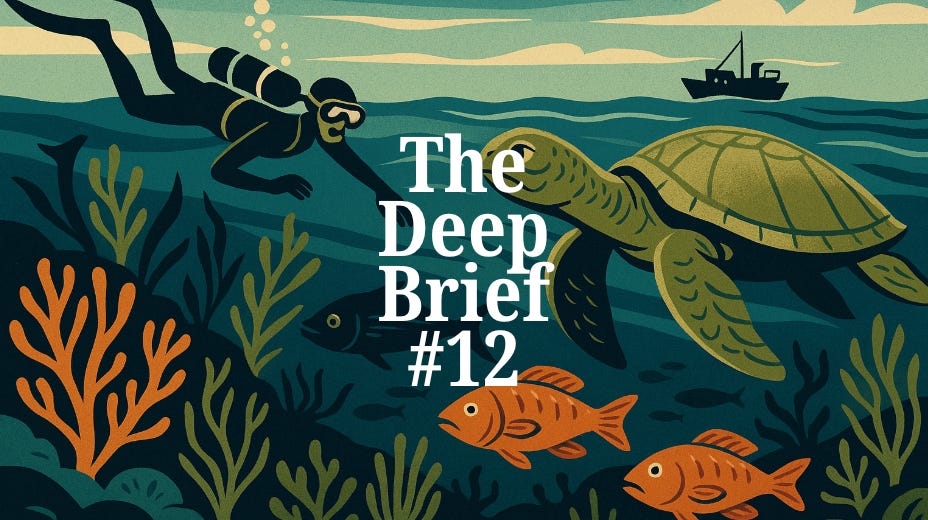The Deep Brief #12 | 6 September 2025
Your end-of-week ocean intelligence, built to inform, agitate and equip you
Each week, I pull together the most urgent, overlooked and powerful stories shaping our relationship with the sea. It is unfiltered, sometimes uncomfortable, but most definitely unmissable.
Three deep dives. Three quick hits. One hard truth from the sea.
Deep Dives
The reef built to outlast climate change
In the Philippines, lawmakers have granted full protection to Panaon Island, home to one of the most climate-resilient coral reefs on Earth. With coral cover well above the national average, this reef sits at the beating heart of the Coral Triangle. The new protected seascape spans more than 60,000 hectares and will impose speed limits on vessels to protect whales and dolphins, alongside a long-term management plan.
Read more →
Microbes rewriting life’s playbook
Ocean microbes, the invisible engines of planetary chemistry, are showing us how evolution actually works step by step. New research highlights how “jumping genes” and gene loss drive adaptation in these communities. These changes help microbes survive in extreme conditions and maintain global cycles of carbon, oxygen, and nutrients. Understanding this microbial choreography could reshape how we model resilience and tipping points in the Earth system.
Learn more →
Bubble curtain for survival
South Australia has deployed an experimental “bubble curtain” to shield tens of thousands of giant cuttlefish eggs from a deadly algal bloom creeping toward Spencer Gulf. The 200 m by 100 m barrier is designed to activate only if the bloom encroaches, buying the species a fighting chance. Scientists fear that without intervention, one toxic wave could erase decades of conservation progress.
Explore →
Three Quick Hits
Europe’s hidden ocean fortune: Off Europe’s coast, researchers have confirmed one of the largest marine “treasures” ever measured. A cold-water ecosystem yields 45,000 tonnes of biomass a year. It is the kind of find that tempts governments to see food, miners to see fuel, and conservationists to see a last chance.
More →
Mangroves on fast-forward seas: Scientists now warn mangrove recovery cannot keep pace with warming oceans. Even as seedlings sprout in restoration zones, rising temperatures threaten to outstrip their survival, leaving coastlines exposed. It is like bailing water from a boat while someone drills new holes in the hull.
More →
Actuaries price the end of certainty: Actuaries, the mathematicians of risk, are factoring ocean collapse into their models. Storm payouts, collapsing fisheries, climate-driven migration. If the bean-counters are worried, it means the crisis has officially arrived in the language of money.
More →
One Hard Truth
The ocean’s future is doubling down
A new global study projects that impacts from climate change and human exploitation will more than double by 2050. Tropical and polar waters will change fastest, with coastal zones absorbing the heaviest blows. Warming seas and declining fish stocks dominate the picture, and the risks cascade outward: deoxygenation, acidification, collapsing food webs, and the erosion of coastal protection systems like mangroves and salt marshes.
This is not a story of distant centuries. It is within one human generation. The research, led by Ben Halpern and colleagues, pulls together multiple stressors into a single map of risk. What it shows is sobering. The very regions that depend most on the ocean for food and livelihoods, from small island nations to Arctic communities, are the ones most exposed.
The hard truth is that the trajectory is already steepening. Even if emissions peaked tomorrow, lag effects in the climate system mean ocean change is locked in for decades. The scale of damage is not fixed, though. Stronger fisheries management, rapid decarbonisation, and targeted protection of habitats with high ecological and carbon value could still blunt the blow. Delay makes the cost steeper and the recovery window narrower.
The other uncomfortable truth is that adaptation is not evenly available. Wealthy nations may buffer their coastlines with concrete or import seafood from elsewhere. Poorer nations will not have that option. The inequity embedded in ocean collapse is one of its most corrosive features.
The ocean’s future is not just a scientific projection. It is a moral test. The doubling of impacts by 2050 is not inevitable. It is the baseline we are on if action remains half-hearted. Every delay is a choice to accept a steeper fall. Every cut in emissions or hectare of reef protected is a choice to change the slope.
Final Thought
This week’s stories circle around resilience. Reefs, microbes, cuttlefish and mangroves all show strength, yet resilience has limits. Some thresholds bend, others snap.
Picture a ledger. On one side, cold-water ecosystems storing 45,000 tonnes of living wealth a year. On the other, insurance actuaries scribbling down the costs of collapse. Between them sits a child on a beach, digging in the sand, unaware that the line between fortune and loss is shifting beneath their feet.
The ocean does not ask us to save it. It asks us to stop pushing it past the point of no return.
Thank you to everyone who has become a Founding Member or paid subscriber this week. Your support keeps these stories free for anyone, anywhere, because the ocean’s truth should never be locked behind a paywall.
See you next week.
– Luke




Bubble curtains, green hydrogen, mangroves, actuaries. Fascinating information, Luke! I just hope humankind heeds this message. Thanks for posting.